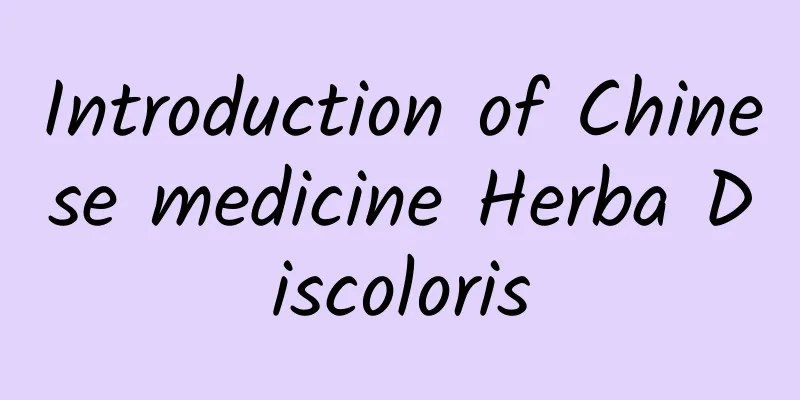Introduction of Chinese medicine Herba Discoloris

|
In this situation where many of us prefer to use Western medicine, we know less and less about traditional Chinese medicine. Today, I will introduce to you the traditional Chinese medicine Herba Dianthus fangbaicao. You can take a look with me at the medicinal value of the traditional Chinese medicine Herba Dianthus fangbaicao and what benefits it can bring to our body. Potentilla discolor is a perennial herb with hypertrophic roots, conical, odd-pinnate compound leaves, basal leaves with 8 to 11 pairs of leaflets, the apical leaflets are the largest, and the leaflets on both sides gradually become smaller downwards. The leaflets are narrow and elliptical, 2 to 5 cm long and 8 to 15 mm wide. There are 1-2 stem leaves with 3-5 palmate leaflets; the pedicels are 1-2.5 cm long and covered with cotton hairs; the flowers are 1-2 cm in diameter; the achenes are nearly kidney-shaped, about 1 mm wide, and smooth. Flowering and fruiting period is from May to September. It can be used as medicine. It generally grows in grasslands on low hillsides or in grass under sparse forests. It is mainly produced in Shandong, Liaoning and Anhui. The whole plant can be used as medicine to clear away heat and detoxify, cool blood and stop bleeding. It can treat dysentery, diarrhea, leucorrhea, malaria, vomiting blood, bloody stool, bleeding from trauma, abdominal pain due to dysentery, chronic dysentery, hemorrhoid bleeding, carbuncles and sores. Perennial herb. The roots are much branched, and the lower part is often thick and spindle-shaped. The flower stem is erect, ascending or slightly spreading, 10-45 cm high, densely covered with white wool. Basal leaves have 2-4 pairs of leaflets, 0.8-1.5cm apart, 4-20cm long including petiole, petiole densely covered with white wool, sometimes with long villous hairs; leaflets opposite or alternate, sessile, leaflets oblong or oblong-lanceolate, 1-5cm long, 0.5-0.8cm wide, apex obtuse, rarely acute, base cuneate, broadly cuneate or obliquely rounded, margin obtuse-serrate, rarely acute, dark green above, covered with sparse white wool or falling off and almost glabrous, densely covered with white or grayish white wool below, veins inconspicuous or slightly obvious, cauline leaves 1-2, with palmate 3-5 leaflets; basal leaf stipules membranous, brown, covered with white long villous hairs outside, cauline leaf stipules herbaceous, green, ovate or broadly ovate, margin often with notched teeth, rarely entire, densely covered with white wool below. The cyme has several to many flowers, which are sparse, with pedicels 1-2.5 cm long and covered with cotton wool on the outside; the flower diameter is 1-2 cm; the sepals are triangular-ovate, the epicalyx segments are lanceolate, shorter than the sepals, and covered with white cotton wool on the outside; the petals are yellow, obovate, slightly concave or obtuse at the apex, and longer than the sepals; the style is nearly terminal, with a nipple-like swelling at the base, and the stigma is slightly enlarged. Achenes nearly reniform, about 1 mm wide, smooth. Flowering and fruiting period is from May to September. Treatment of cervical lymph node tuberculosis: Take 1.5-2 liang of whole herb of Herba Pogostemonissima, soak it in 1.5 jin of yellow wine (those who are not good at drinking can reduce the amount) for 1 day and night, simmer it in soup for about 1 hour until there is no smell of alcohol, add appropriate amount of brown sugar, take it once or several times a day. Take 1 dose daily or every other day, 15 doses for one course of treatment. If necessary, stop taking the medicine for 5 days and then continue the second course of treatment. Eleven cases were treated, most of whom had not responded to streptomycin and other anti-tuberculosis drugs. After 1 to 2 courses of medication, inflammation around the cervical lymph nodes subsided and the lumps disappeared in 8 cases. In fact, Chinese medicine is also very beneficial to our body. Sometimes we should not just use Western medicine blindly. Appropriate use of some Chinese medicine can also bring many benefits to our condition. Moreover, many Chinese medicines are no longer difficult to swallow, and more of them appear in the form of pills. |
<<: Functions and indications of Chinese medicine five-fingered peach
>>: What are the common Chinese medicinal herbs for health preservation?
Recommend
The efficacy and function of Strychnos nux vomica
Strychnos nux vomica is a plant that many people ...
The efficacy and function of black face Fangji
Traditional Chinese medicine often has unexpected...
Can eating deer penis really improve sexual performance?
Deer penis is a very common Chinese medicinal mat...
Another huge step forward! OpenAI o1 is here. How does it solve complex problems?
Produced by: Science Popularization China Author:...
Why does my throat feel bitter after putting in eye drops?
Audit expert: Liu Dongbao Chief Physician of Opht...
"Xuanwu" supports Hebei's "Grassland Sky Road"
Xuanwu is an ancient divine tortoise with 13 hexa...
What is the method of taking Panax notoginseng powder to remove freckles?
Panax notoginseng powder is a powder made from th...
The efficacy and function of vinegar bupleurum
There are many kinds of diseases in daily life, a...
The efficacy and contraindications of Tiepi Fengdou
Nowadays, many friends have given up choosing som...
This place is much more interesting than Pandora...
Tadpole Jun guessed that the most exciting thing ...
Iron deficiency can lead to
Iron deficiency in the body can affect brain deve...
Can obsessive compulsive disorder lead to suicide?
Obsessive-compulsive disorder is a relatively ser...
Why do we need to go to space to develop quantum communications?
“Things are accomplished through secrecy and ruin...
They love candied haws more than nectar. Are these bees stupid?
Author: Shi Jun Reviewer: Yao Jun (Associate Rese...
What is the method of external application of dried dandelion?
In the eyes of most young people, dandelions are ...









